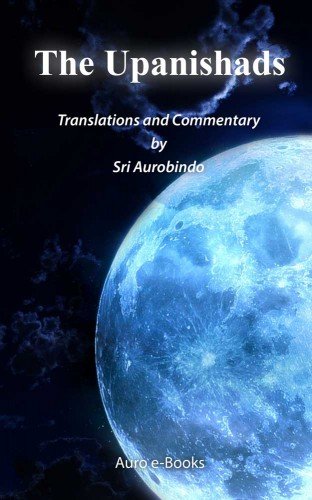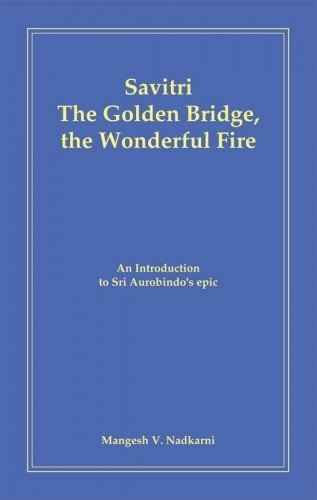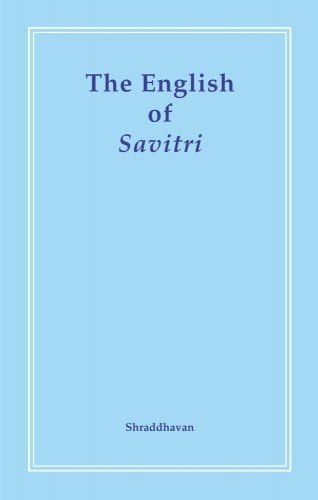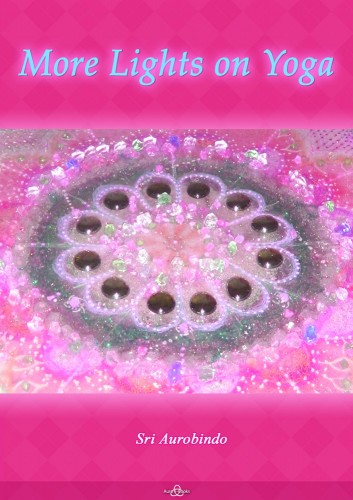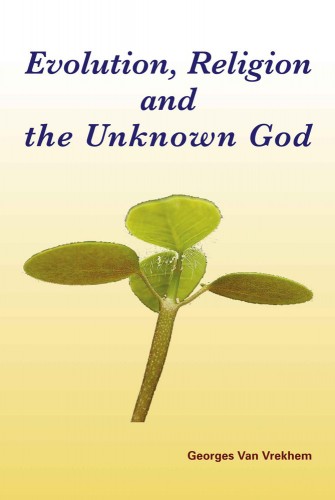Isha Upanishad
ISHA UPANISHAD
Translated by Sri Aurobindo in “Arya” August 1914
(With transcription of the original text in Sanskrit and notes of the translator)
īśā vāsyamidaḿ sarvaṁ yat kiñca jagatyāṁ jagat ǀ
tena tyaktena bhuñjīthā mā gṛdhaḥ kasya sviddhanam ǁ
- All this is for habitation1 by the Lord, whatsoever is individual universe of movement in the universal motion. By that renounced thou shouldst enjoy; lust not after any man’s possession.
kurvanneveha karmāṇi jijīviṣecchataḿ samāḥ ǀ
evaṁ tvayi nānyatheto’sti na karma lipyate nare ǁ
- Doing verily2 works in this world one should wish to live a hundred years. Thus it is in thee and not otherwise than this; action cleaves not to a man. 3
asūryā nāma te lokā andhena tamasā’’vṛtāḥ ǀ
tāḿste pretyābhigacchanti ye ke cātmahano janāḥ ǁ
- Sunless4 are those worlds and enveloped in blind gloom whereto all they in their passing hence resort who are slayers of their souls.
anejadekaṁ manaso javīyo nainaddevā āpnuvan pūrvamarṣat ǀ
taddhāvato’nyānatyeti tiṣṭhat tasminnapo mātariśvā dadhāti ǁ
- One unmoving that is swifter than Mind, That the Gods reach not, for It progresses ever in front. That, standing, passes beyond others as they run. In That the Master of Life5 establishes the Waters. 6
tadejati tannaijati tad dūre tadvantike ǀ
tadantarasya sarvasya tadu sarvasyāsya bāhyataḥ ǁ
- That moves and That moves not; That is far and the same is near; That is within all this and That also is outside all this.
yastu sarvāṇi bhūtāni ātmanyevānupaśyati ǀ
sarvabhūteṣu cātmānaṁ tato na vijugupsate ǁ
- But he who sees everywhere the Self in all existences and all existences in the Self, shrinks not thereafter from aught.
yasmin sarvāṇi bhūtāni ātmaivābhūd vijānataḥ ǀ
tatra ko mohaḥ kaḥ śoka ekatvamanupaśyataḥ ǁ
- He in whom it is the Self-Being that has become all existences that are Becomings7 for he has the perfect knowledge, how shall he be deluded, whence shall he have grief who sees everywhere oneness?
sa paryagācchukramakāyamavraṇamasnāviraṁ śuddhamapāpaviddham ǀ
kavirmanīṣī paribhūḥ svayambhur yāthātathyato’rthān vyadadhācchāśvatībhyaḥ samābhyaḥ ǁ
- It is He that has gone abroad — That which is bright, bodiless, without scar of imperfection, without sinews, pure, unpierced by evil. The Seer, the Thinker,8 the One who becomes everywhere, the Self-existent has ordered objects perfectly according to their nature from years sempiternal.
andhaṁ tamaḥ praviśanti ye’vidyāmupāsate ǀ
tato bhūya iva te tamo ya u vidyāyāḿ ratāḥ ǁ
- Into a blind darkness they enter who follow after the Ignorance, they as if into a greater darkness who devote themselves to the Knowledge alone.
anyadevāhurvidyayā’nyadāhuravidyayā ǀ
iti śuśruma dhīrāṇāṁ ye nastadvicacakṣire ǁ
- Other, verily,9 it is said, is that which comes by the Knowledge, other that which comes by the Ignorance; this is the lore we have received from the wise who revealed That to our understanding.
vidyāñcāvidyāñca yastadvedobhayaḿ saha ǀ
avidyayā mṛtyuṁ tīrtvā vidyayā’mṛtamaśnute ǁ
- He who knows That as both in one, the Knowledge and the Ignorance, by the Ignorance crosses beyond death and by the Knowledge enjoys Immortality.
andhaṁ tamaḥ praviśanti ye’sambhūtimupāsate ǀ
tato bhūya iva te tamo ya u sambhūtyāḿ ratāḥ ǁ
- Into a blind darkness they enter who follow after the Non-Birth, they as if into a greater darkness who devote themselves to the Birth alone.
anyadevāhuḥ sambhavādanyadāhurasambhavāt ǀ
iti śuśruma dhīrāṇāṁ ye nastadvicacakṣire ǁ
- Other, verily, it is said, is that which comes by the Birth, other that which comes by the Non-Birth; this is the lore we have received from the wise who revealed That to our understanding.
sambhūtiñca vināśañca yastadvedobhayaḿ saha ǀ
vināśena mṛtyuṁ tīrtvā sambhūtyā’mṛtamaśnute ǁ
- He who knows That as both in one, the Birth and the dissolution of Birth, by the dissolution crosses beyond death and by the Birth enjoys Immortality.
hiraṇmayena pātreṇa satyasyāpihitaṁ mukham ǀ
tat tvaṁ pūṣannapāvṛṇu satyadharmāya dṛṣṭaye ǁ
- The face of Truth is covered with a brilliant golden lid; that do thou remove, O Fosterer,10 for the law of the Truth, for sight.
pūṣannekarṣe yama sūrya prājāpatya vyūha raśmīn samūha ǀ
tejo yat te rūpaṁ kalyāṇatamaṁ tatte paśyāmi
yo’sāvasau puruṣaḥ so’hamasmi ǁ
- O Fosterer, O sole Seer, O Ordainer, O illumining Sun, O power of the Father of creatures, marshal thy rays, draw together thy light; the Lustre which is thy most blessed form of all, that in Thee I behold. The Purusha there and there, He am I.
vāyuranilamamṛtamathedaṁ bhasmāntaḿ śarīram ǀ
OM krato smara kṛtaḿ smara krato smara kṛtaḿ smara ǁ
- The Breath of things11 is an immortal Life, but of this body ashes are the end. OM! O Will,12 remember, that which was done remember! O Will, remember, that which was done, remember.
agne naya supathā rāye asmān viśvāni deva vayunāni vidvān ǀ
yuyodhyasmajjuhurāṇameno bhūyiṣṭhāṁ te namauktiṁ vidhema ǁ
- O god Agni, knowing all things that are manifested, lead us by the good path to the felicity; remove from us the devious attraction of sin. 13 To thee completest speech of submission we would dispose. 14
1 There are three possible senses of vasyam, “to be clothed”, “to be worn as a garment” and “to be inhabited”. The first is the ordinarily accepted meaning. Shankara explains it in this significance, that we must lose the sense of this unreal objective universe in the sole perception of the pure Brahman. So explained the first line becomes a contradiction of the whole thought of the Upanishad which teaches the reconciliation, by the perception of essential Unity, of the apparently incompatible opposites. God and the World, Renunciation and Enjoyment, Action and internal Freedom, the One and the Many, Being and its Becomings, the passive divine Impersonality and the active divine Personality, the Knowledge and the Ignorance, the Becoming and the Not-Becoming, Life on earth and beyond and the supreme Immortality. The image is of the world either as a garment or as a dwelling-place for the informing and governing Spirit. The latter significance agrees better with the thought of the Upanishad.
2 Kurvanneva. The stress of the word eva gives the force, “doing works indeed, and not refraining from them”.
3 Shankara reads the line, “Thus in thee — it is not otherwise than thus — action cleaves not to a man.” He interprets karmani in the first line in the sense of Vedic sacrifices which are permitted to the ignorant as a means of escaping from evil actions and their results and attaining to heaven, but the second karma in exactly the opposite sense, “evil action”. The verse, he tells us, represents a concession to the ignorant; the enlightened soul abandons works and the world and goes to the forest. The whole expression and construction in this rendering become forced and unnatural. The rendering I give seems to me the simple and straightforward sense of the Upanishad.
4 We have two readings, asūryāh. sunless, and asuryāh, Titanic or undivine. The third verse is, in the thought structure of the Upanishad, the starting-point for the final movement in the last four verses. Its suggestions are there taken up and worked out. The prayer to the Sun refers back in thought to the sunless worlds and their blind gloom, which are recalled in the ninth and twelfth verses. The sun and his rays are intimately connected in other Upanishads also with the worlds of Light and their natural opposite is the dark and sunless, not the Titanic worlds.
5 Mātariśvan seems to mean “he who extends himself in the Mother or the container” whether that be the containing mother element, Ether, or the material energy called Earth in the Veda and spoken of there as the Mother. It is a Vedic epithet of the God Vayu, who, representing the divine principle in the Life-energy, Prana, extends himself in Matter and vivifies its forms. Here it signifies the divine Life-power that presides in all forms of cosmic activity.
6 Apas, as it is accentuated in the version of the White Yajurveda, can mean only “waters”. If this accentuation is disregarded, we may take it as the singular apas, work, action. Shankara, however, renders it by the plural, works. The difficulty only arises because the true Vedic sense of the word had been forgotten and it came to be taken as referring to the fourth of the five elemental states of Matter, the liquid. Such a reference would be entirely irrelevant to the context. But the Waters, otherwise called the seven streams or the seven fostering Cows, are the Vedic symbol for the seven cosmic principles and their activities, three inferior, the physical, vital and mental, four superior, the divine Truth, the divine Bliss, and divine Will and Consciousness, and the divine Being. On this conception also is founded the ancient idea of the seven worlds in each of which the seven principles are separately active by their various harmonies. This is, obviously, the right significance of the word in the Upanishad.
7 The words sarvāṇi bhūtāni literally, “all things that have become”, is opposed to Atman, self-existent and immutable being. The phrase means ordinarily “all creatures”, but its literal sense is evidently insisted on in the expression bhūtāni abhūt “became the Becomings”. The idea is the acquisition in man of the supreme consciousness by which the one Self in him extends itself to embrace all creatures and realises the eternal act by which that One manifests itself in the multiple forms of the universal motion.
8 There is a clear distinction in Vedic thought between kavi, the seer and manīṣī, the thinker. The former indicates the divine supra-intellectual Knowledge which by direct vision and illumination sees the reality, the principles and the forms of things in their true relations, the latter, the labouring mentality, which works from the divided consciousness through the possibilities of things downward to the actual manifestation in form and upward to their reality in the self-existent Brahman.
9 Anyadeva — eva here gives to anyad the force, “Quite other than the result described in the preceding verse is that to which lead the Knowledge and the Ignorance.” We have the explanation of anyad in the verse that follows. The ordinary rendering, “Knowledge has one result. Ignorance another”, would be an obvious commonplace announced with an exaggerated pompousness, adding nothing to the thought and without any place in the sequence of the ideas.
10 In the inner sense of the Veda Surya, the Sun-God, represents the divine Illumination of the Kavi which exceeds mind and forms the pure self-luminous Truth of things. His principal power is self-revelatory knowledge, termed in the Veda, “Sight”. His realm is described as the Truth, the Law, the Vast. He is the Fosterer or Increaser, for he enlarges and opens man’s dark and limited being into a luminous and infinite consciousness. He is the sole Seer, Seer of Oneness and Knower of the Self, and leads him to the highest Sight. He is Yama, Controller or Ordainer for he governs man’s action and manifested being by the direct Law of the Truth, satya-dharma, and therefore by the right principle of our nature, yāthā-tathyatah, a luminous power proceeding from the Father of all existence, he reveals in himself the divine Purusha of whom all beings are the manifestations. His rays are the thoughts that proceed luminously from the Truth, the Vast, but become deflected and distorted, broken up and disordered in the reflecting and dividing principle. Mind. They form there the golden lid which covers the face of the Truth. The Seer prays to Surya to cast them into right order and relation and then draw them together into the unity of revealed truth. The result of this inner process is the perception of the oneness of all beings in the divine Soul of the Universe.
11 Vayu, called elsewhere Matarishwan, the Life-Energy in the universe. In the light of Surya he reveals himself as an immortal principle of existence of which birth and death and life in the body are only particular and external processes.
12 The Vedic term kratu means sometimes the action itself, sometimes the effective power behind action represented in mental consciousness by the will. Agni is this power. He is divine force which manifests first in matter as heat and light and material energy and then, taking different forms in the other principles of man’s consciousness, leads him by a progressive manifestation upwards to the Truth and the Bliss.
13 Sin, in the conception of the Veda, from which this verse is taken bodily, is that which excites and hurries the faculties into deviation from the good path. There is a straight road or road of naturally increasing light and truth, rjuḥ panthāh, ṛtasya panthāḥ, leading over infinite levels and towards infinite vistas, vitā p̣rṣṭhā, by which the law of our nature should normally take us towards our fulfilment. Sin compels it instead to travel with stumblings amid uneven and limited tracts and along crooked windings (duritāni, vṛjināni).
14 The word vidhema is used of the ordering of the sacrifice, the disposal of the offerings to the God and, generally, of the sacrifice or worship itself. The Vedic namas, internal and external obeisance, is the symbol of submission to the divine Being in ourselves and in the world. Here the offering is that of completest submission and the self-surrender of all the faculties of the lower egoistic human nature to the divine Will-force, Agni, so that, free from internal opposition, it may lead the soul of man through the truth towards a felicity full of the spiritual riches, rāye. That state of beatitude is the intended self-content in the principle of pure Love and Joy, which the Vedic initiates regarded as the source of the divine existence in the universe and the foundation of the divine life in the human being. It is the deformation of this principle by egoism which appears as desire and the lust of possession in the lower worlds.

